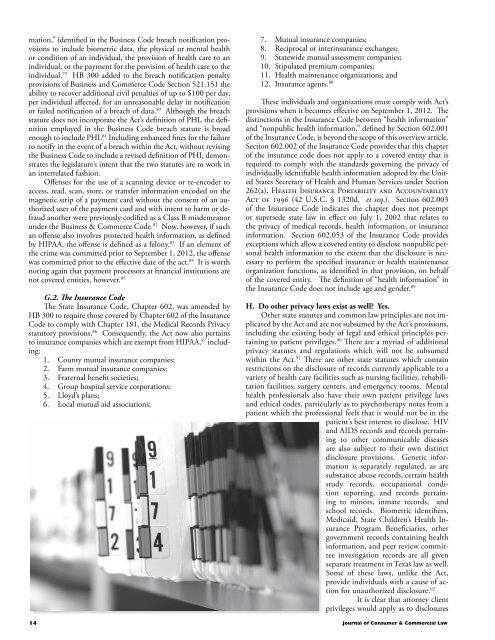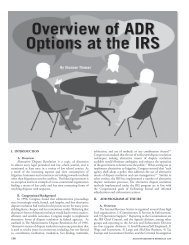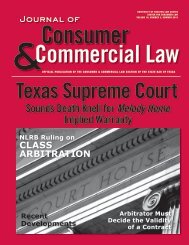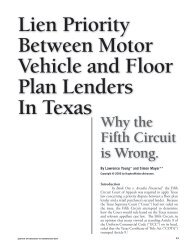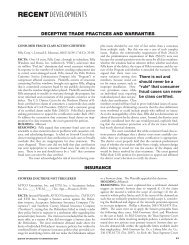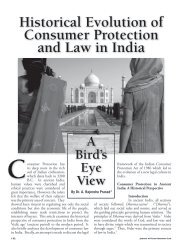Teaching Consumer Credit Law in an Evolving Australian Economy
Teaching Consumer Credit Law in an Evolving Australian Economy
Teaching Consumer Credit Law in an Evolving Australian Economy
You also want an ePaper? Increase the reach of your titles
YUMPU automatically turns print PDFs into web optimized ePapers that Google loves.
mation,” identified <strong>in</strong> the Bus<strong>in</strong>ess Code breach notification provisions<br />
to <strong>in</strong>clude biometric data, the physical or mental health<br />
or condition of <strong>an</strong> <strong>in</strong>dividual, the provision of health care to <strong>an</strong><br />
<strong>in</strong>dividual, or the payment for the provision of health care to the<br />
<strong>in</strong>dividual. 79 HB 300 added to the breach notification penalty<br />
provisions of Bus<strong>in</strong>ess <strong>an</strong>d Commerce Code Section 521.151 the<br />
ability to recover additional civil penalties of up to $100 per day,<br />
per <strong>in</strong>dividual affected, for <strong>an</strong> unreasonable delay <strong>in</strong> notification<br />
or failed notification of a breach of data. 80 Although the breach<br />
statute does not <strong>in</strong>corporate the Act’s def<strong>in</strong>ition of PHI, the def<strong>in</strong>ition<br />
employed <strong>in</strong> the Bus<strong>in</strong>ess Code breach statute is broad<br />
enough to <strong>in</strong>clude PHI. 81 Includ<strong>in</strong>g enh<strong>an</strong>ced f<strong>in</strong>es for the failure<br />
to notify <strong>in</strong> the event of a breach with<strong>in</strong> the Act, without revis<strong>in</strong>g<br />
the Bus<strong>in</strong>ess Code to <strong>in</strong>clude a revised def<strong>in</strong>ition of PHI, demonstrates<br />
the legislature’s <strong>in</strong>tent that the two statutes are to work <strong>in</strong><br />
<strong>an</strong> <strong>in</strong>terrelated fashion.<br />
Offenses for the use of a sc<strong>an</strong>n<strong>in</strong>g device or re-encoder to<br />
access, read, sc<strong>an</strong>, store, or tr<strong>an</strong>sfer <strong>in</strong>formation encoded on the<br />
magnetic strip of a payment card without the consent of <strong>an</strong> authorized<br />
user of the payment card <strong>an</strong>d with <strong>in</strong>tent to harm or defraud<br />
<strong>an</strong>other were previously codified as a Class B misdeme<strong>an</strong>or<br />
under the Bus<strong>in</strong>ess & Commerce Code. 82 Now, however, if such<br />
<strong>an</strong> offense also <strong>in</strong>volves protected health <strong>in</strong>formation, as def<strong>in</strong>ed<br />
by HIPAA, the offense is def<strong>in</strong>ed as a felony. 83 If <strong>an</strong> element of<br />
the crime was committed prior to September 1, 2012, the offense<br />
was committed prior to the effective date of the act. 84 It is worth<br />
not<strong>in</strong>g aga<strong>in</strong> that payment processors at f<strong>in</strong><strong>an</strong>cial <strong>in</strong>stitutions are<br />
not covered entities, however. 85<br />
G.2. The Insur<strong>an</strong>ce Code<br />
The State Insur<strong>an</strong>ce Code, Chapter 602, was amended by<br />
HB 300 to require those covered by Chapter 602 of the Insur<strong>an</strong>ce<br />
Code to comply with Chapter 181, the Medical Records Privacy<br />
statutory provisions. 86 Consequently, the Act now also perta<strong>in</strong>s<br />
to <strong>in</strong>sur<strong>an</strong>ce comp<strong>an</strong>ies which are exempt from HIPAA, 87 <strong>in</strong>clud<strong>in</strong>g:<br />
1. County mutual <strong>in</strong>sur<strong>an</strong>ce comp<strong>an</strong>ies;<br />
2. Farm mutual <strong>in</strong>sur<strong>an</strong>ce comp<strong>an</strong>ies;<br />
3. Fraternal benefit societies;<br />
4. Group hospital service corporations;<br />
5. Lloyd’s pl<strong>an</strong>s;<br />
6. Local mutual aid associations;<br />
7. Mutual <strong>in</strong>sur<strong>an</strong>ce comp<strong>an</strong>ies;<br />
8. Reciprocal or <strong>in</strong>ter<strong>in</strong>sur<strong>an</strong>ce exch<strong>an</strong>ges;<br />
9. Statewide mutual assessment comp<strong>an</strong>ies;<br />
10. Stipulated premium comp<strong>an</strong>ies;<br />
11. Health ma<strong>in</strong>ten<strong>an</strong>ce org<strong>an</strong>izations; <strong>an</strong>d<br />
12. Insur<strong>an</strong>ce agents. 88<br />
These <strong>in</strong>dividuals <strong>an</strong>d org<strong>an</strong>izations must comply with Act’s<br />
provisions when it becomes effective on September 1, 2012. The<br />
dist<strong>in</strong>ctions <strong>in</strong> the Insur<strong>an</strong>ce Code between “health <strong>in</strong>formation”<br />
<strong>an</strong>d “nonpublic health <strong>in</strong>formation,” def<strong>in</strong>ed by Section 602.001<br />
of the Insur<strong>an</strong>ce Code, is beyond the scope of this overview article.<br />
Section 602.002 of the Insur<strong>an</strong>ce Code provides that this chapter<br />
of the <strong>in</strong>sur<strong>an</strong>ce code does not apply to a covered entity that is<br />
required to comply with the st<strong>an</strong>dards govern<strong>in</strong>g the privacy of<br />
<strong>in</strong>dividually identifiable health <strong>in</strong>formation adopted by the United<br />
States Secretary of Health <strong>an</strong>d Hum<strong>an</strong> Services under Section<br />
262(a), Health Insur<strong>an</strong>ce Portability <strong>an</strong>d Accountability<br />
Act of 1996 (42 U.S.C. § 1320d, et seq.). Section 602.003<br />
of the Insur<strong>an</strong>ce Code <strong>in</strong>dicates the chapter does not preempt<br />
or supersede state law <strong>in</strong> effect on July 1, 2002 that relates to<br />
the privacy of medical records, health <strong>in</strong>formation, or <strong>in</strong>sur<strong>an</strong>ce<br />
<strong>in</strong>formation. Section 602.053 of the Insur<strong>an</strong>ce Code provides<br />
exceptions which allow a covered entity to disclose nonpublic personal<br />
health <strong>in</strong>formation to the extent that the disclosure is necessary<br />
to perform the specified <strong>in</strong>sur<strong>an</strong>ce or health ma<strong>in</strong>ten<strong>an</strong>ce<br />
org<strong>an</strong>ization functions, as identified <strong>in</strong> that provision, on behalf<br />
of the covered entity. The def<strong>in</strong>ition of “health <strong>in</strong>formation” <strong>in</strong><br />
the Insur<strong>an</strong>ce Code does not <strong>in</strong>clude age <strong>an</strong>d gender. 89<br />
H. Do other privacy laws exist as well? Yes.<br />
Other state statutes <strong>an</strong>d common law pr<strong>in</strong>ciples are not implicated<br />
by the Act <strong>an</strong>d are not subsumed by the Act’s provisions,<br />
<strong>in</strong>clud<strong>in</strong>g the exist<strong>in</strong>g body of legal <strong>an</strong>d ethical pr<strong>in</strong>ciples perta<strong>in</strong><strong>in</strong>g<br />
to patient privileges. 90 There are a myriad of additional<br />
privacy statutes <strong>an</strong>d regulations which will not be subsumed<br />
with<strong>in</strong> the Act. 91 There are other state statutes which conta<strong>in</strong><br />
restrictions on the disclosure of records currently applicable to a<br />
variety of health care facilities such as nurs<strong>in</strong>g facilities, rehabilitation<br />
facilities, surgery centers, <strong>an</strong>d emergency rooms. Mental<br />
health professionals also have their own patient privilege laws<br />
<strong>an</strong>d ethical codes, particularly as to psychotherapy notes from a<br />
patient which the professional feels that it would not be <strong>in</strong> the<br />
patient’s best <strong>in</strong>terest to disclose. HIV<br />
<strong>an</strong>d AIDS records <strong>an</strong>d records perta<strong>in</strong><strong>in</strong>g<br />
to other communicable diseases<br />
are also subject to their own dist<strong>in</strong>ct<br />
disclosure provisions. Genetic <strong>in</strong>formation<br />
is separately regulated, as are<br />
subst<strong>an</strong>ce abuse records, certa<strong>in</strong> health<br />
study records, occupational condition<br />
report<strong>in</strong>g, <strong>an</strong>d records perta<strong>in</strong><strong>in</strong>g<br />
to m<strong>in</strong>ors, <strong>in</strong>mate records, <strong>an</strong>d<br />
school records. Biometric identifiers,<br />
Medicaid, State Children’s Health Insur<strong>an</strong>ce<br />
Program Beneficiaries, other<br />
government records conta<strong>in</strong><strong>in</strong>g health<br />
<strong>in</strong>formation, <strong>an</strong>d peer review committee<br />
<strong>in</strong>vestigation records are all given<br />
separate treatment <strong>in</strong> Texas law as well.<br />
Some of these laws, unlike the Act,<br />
provide <strong>in</strong>dividuals with a cause of action<br />
for unauthorized disclosure. 92<br />
It is clear that attorney client<br />
privileges would apply as to disclosures<br />
14 Journal of <strong>Consumer</strong> & Commercial <strong>Law</strong>


